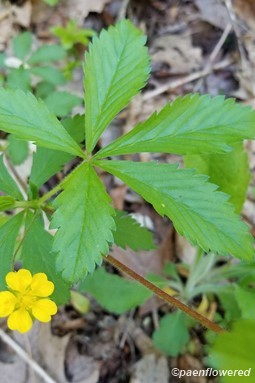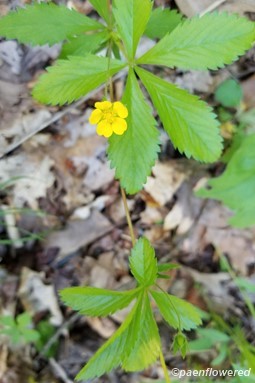Potentilla simplex
A common inhabitant of fields and dry woods
Potentilla simplex common cinquefoil
This perennial native plant of the rose family is named for its 5-part palmately compound leaves. The leaflets are 2.5 inches long on average and about 0.75 inches wide. The leaflets are toothed, except near the base and have prominent veins. The plant sprawls close to the ground by means of horizontal stems called stolons or runners that form roots at the nodes. These runners can be 6 to 20 inches long. They are initially green, but turn red with age. Both the flowers and leaves rise from the runners on separate stalks.
The flowers are about ½ inch in diameter with 5 yellow petals, each rounded on the ends and narrow at the base. The first flower rises from the axil of the second leaf. The flowers are reasonably showy in the spring but only a few flowers are in bloom at any time. These flowers have no noticeable scent. Small bees and flies are the major pollinators.
This plant is common in fields and dry woods in most of the eastern half of North America, though it is more common in the north. It is documented in every county in Pennsylvania. The blooming period is from late April to late June. In lawns and gardens it is often considered a weed. It often grows low enough to survive mowing, though cutting may reduce its size. The common cinquefoil is also known by the name of five-fingers or old field cinquefoil.
The Canadian dwarf cinquefoil (P. canadensis) is very similar but has smaller leaflets (1.5 inches long on average) that are wedge-shaped with more rounded teeth. The stems are densely hairy and there are no teeth on the lower half of the leaves. In common cinquefoil teeth are pointed and extended further down the leaf margin than in the dwarf cinquefoil. There are also only a few tiny hairs on the stem.
Common cinquefoil is sometimes mistaken for wild strawberry, but the latter has white flowers and fewer leaflets per leaf. Native Americans made a tea from the common cinquefoil leaves and used it to treat diarrhea and stomachache. When boiled or roasted the roots taste like parsnips, but it has only generally been used as a famine food. A more upright member of the cinquefoil group is the sulfur cinquefoil (P. recta).
Habitat & Range
Common in dry woods, fields, meadows, and roadsides. Prefers partial to full sun and drained soil.
Present throughout the state.
Range: Native to eastern North America. From Ontario and Nova Scotia in Canada down to Maine, Georgia, and Texas in the United States, reaching as far west as Nebraska
| EMP: | FACU |
|---|---|
| NCNE: | FACU |
Phenology
Flowers May through July.
Characteristics
Inflorescence axillary with long-stalked solitary flowers
Flowers 5 yellow petals, 5 green sepals shorter than petals; stamens numerous with yellow anthers; ½″ across
Leaves palmately compound with 5 leaflets;
leaflets lanceolate, margins serrate except near base, tapered at base with middle leaflet largest, end pair smallest; prominent veins; up to 3″ long, up to 1″ wide
Stems stoloniferous, hairy; green & red with age;
Height 6 to 12 inches
Similar Species
Potentilla canadensis
terminal leaflet usually obovate; with teeth extending less than half way to the base while P. simplex terminal leaflet is usually ovate; with teeth extending more than half way to the base
first flower arises from the first node on the stem, while in P. simplex the first flower arises from the second node on the stem
Plant Codes
S-rank: S5 (Secure)
G-rank: G5 (Secure)
Ecology
Main pollinators are small bees and flies like Mason bees, carpenter bees, syrphid flies and tachinid flies.
Foliage is often eaten by small mammals and herbivores like rabbits and groundhogs. Not favored by deer.







Comments
Have you spotted this plant in your area? We'd love to hear about your experience! Share your comments or questions about the plant below. Comments are moderated before posting.